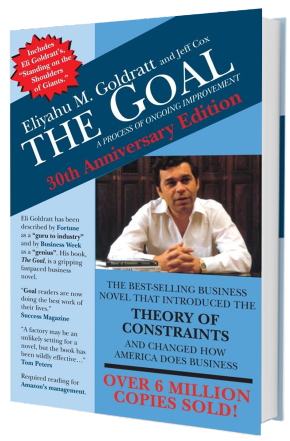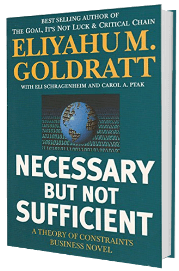Resources
Resources to help you solve persistent operations and supply chain problems for more productivity, revenue and profitability.

Essential reading
The Goal
What it is
One the world’s most-influential business books. In it, renowned author Eli Goldratt explains why traditional efficiency improvement methods fail, and offers a breakthrough alternative.
Why we recommend it
Everything we do is based on the Theory of Constraints methods outlined here. There’s no better way to learn what it is, and how we use it to drive-up performance.
Let us give you a free copy
Essential reading
Necessary But Not Sufficient
What it is
“To realize value, bottom-line value, technology is Necessary but Not Sufficient.” NBNS outlines why most ERP investments, while often necessary, are not sufficient to deliver sustainable business results. System-wide based business management methodology and associated behaviour changes need to be driven outside of a technology platform to solve supply chain and operations management problems.
Why we recommend it
In its analysis of supply chain technology, NBNS ultimately outlines the basis for Demand Driven Replenishment and Production Management approaches and prescribes how to leverage your ERP investment to increase availability, reduce inventory and maximize system throughput.
Let us give you a free copyFEATURED POSTS
How to Make Manufacturing Strong Again
We break down the key reasons why manufacturers struggle to improve productivity and profitability, and how to turn it around.
4 reasons ERPs fail to achieve business goals
ERP investments are soaring, but most still fail to deliver the desired benefits. We explain 4 reasons why your ERP is missing the mark.
New inventory management approach improves bottom-line results
It’s easy for manufacturers to get stuck making incremental improvements. Here’s how Stalmax made the leap to impressive results in just 10 months.
ALL POSTS
6 questions to evaluate a tech investment
Consider these 6 questions from Theory of Constraints to evaluate your next tech purchase.
The power of flow
Montera’s Flow Management System helps manufacturers increase ‘flow’ for more revenue and profitability.
Increasing shareholder value with Theory of Constraints
TOC applications resulted in significant improvements to five companies’ performance and bottom line results
CCPM for faster, lower-cost projects
Critical Chain Project Management (CCPM) is a Theory of Constraints approach to deliver projects better, faster and for lower cost.
Tariffs: The Ultimate External Constraint
How to use Throughput Economics tools to manage external constraints (e.g., tariffs) for a profitable path forward.
What constraint is holding your business back?
To find the key constraint holding your operation back, you need to step back and look at the entire business.

